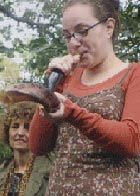New Communities

Recent years have seen a surge of new Jewish communities: experiments in communal living like Moishe House, urban kibbutzim in Israel's inner cities, back-to-nature programs combining organic farming, kashrut, and "eco-justice," and, perhaps most notably, independent minyanim in the U.S., Israel, and elsewhere. These last—communities focused principally or exclusively on prayer—shun not only the formality and organizational heft of most synagogues but also the labels and authority of denominational Judaism. Some of the most prominent have been created by Orthodox Jews seeking to make room for greater participation by women; others comprise young people experimenting with their own forms of prayer and spiritual experience.
New communities are themselves hardly new in Jewish history, some of whose deepest transformations were wrought by small groups translating their common understandings into the language of ideas and rituals. Such goups include the kabbalists of 16th-century Safed, memorably sketched by Solomon Schechter in his classic Studies in Judaism; the Ba'al Shem Tov and his disciples, the founders of Hasidism; and the earliest generations of kibbutzniks. Closer to our own time, the American havurah (fellowship) movement, sparked by the 1960s counterculture, would bequeath its name to a plethora of small-scale communities ranging today from highly traditional prayer cells to groups promoting social activism, sexual diversity, and chi gong but little or no prayer.
As these examples may suggest, the vitality of a new community doesn't last forever. Most, sooner or later, either institutionalize themselves, become marginal, or die out—until the next surge comes along. The question for all of them is the same as for established communities: what they will leave behind. Experience suggests that the answer is the same as well: everything depends on the intensity of their learning, the depth of their identification with the Jewish people, the faithfulness of their prayer.
Comments are closed for this article.




